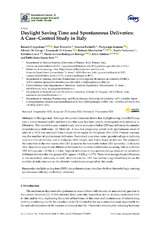Daylight Saving Time and Spontaneous Deliveries: A Case–Control Study in Italy
Autor
Cappadona, Rosaria
Puzzarini, Sara
Farinelli, Vanessa
Iannone, Piergiorgio
Giorgi, Alfredo De
Simone, Emanuele Di
Manfredini, Roberto
Verteramo, Rosita
Greco, Pantaleo
Rodríguez Borrego, M.A.
Fabbian, Fabio
López Soto, Pablo Jesús
Editor
MDPIFecha
2020Materia
Daylight saving time (DST)Desynchronization
Circadian rhythm
Chronobiology
Nursing
Spontaneous delivery
Midwifery
Obstetrics
METS:
Mostrar el registro METSPREMIS:
Mostrar el registro PREMISMetadatos
Mostrar el registro completo del ítemResumen
(1) Background: Although the current literature shows that daylight saving time (DST) may play a role in human health and behavior, this topic has been poorly investigated with reference to Obstetrics. The aim of this case–control study was to evaluate whether DST may influence the number of spontaneous deliveries. (2) Methods: A low-risk pregnancy cohort with spontaneous onset of labor (n = 7415) was analyzed from a single Italian region for the period 2016–2018. Primary outcome was the number of spontaneous deliveries. Secondary outcomes were: gestational age at delivery, type and time of delivery, use of analgesia, birth weight, and 5-min Apgar at delivery. We compared the outcomes in the two weeks after DST (cases) to the two weeks before DST (controls). (3) Results: Data showed no significant difference between the number of deliveries occurring before and after DST (Chi-square = 0.546, p = 0.46). Vaginal deliveries at any gestational age showed no statistical difference between the two groups (Chi-square = 0.120, p = 0.73). There were no significant differences in the secondary outcomes, as well. (4) Conclusions: DST has neither a significant impact on the number of deliveries nor on the obstetric variables investigated by this study.

